food processing.ppt
- Количество слайдов: 39
 INTRODUCTION l THE FOOD PROCESSING INDUSTRY l HISTORY OF FOOD PROCESSING l PROCESSING CONCEPTS l GENERAL PROCESSING CONCEPTS l SUMMARY
INTRODUCTION l THE FOOD PROCESSING INDUSTRY l HISTORY OF FOOD PROCESSING l PROCESSING CONCEPTS l GENERAL PROCESSING CONCEPTS l SUMMARY
 Vocabulary l food processing, preservation, raw materials, ingredients, marine materials, intermediate, foodstuffs, value added, kindred manufacture or process, animals, fowl, dairy products, canned and preserved fruits and vegetables, grain mill products, bakery products, sugar and confectionery products, beverages, sophistication, shelf life, thermal energy
Vocabulary l food processing, preservation, raw materials, ingredients, marine materials, intermediate, foodstuffs, value added, kindred manufacture or process, animals, fowl, dairy products, canned and preserved fruits and vegetables, grain mill products, bakery products, sugar and confectionery products, beverages, sophistication, shelf life, thermal energy
 Vocabulary 2 l commercial refrigeration, orange juice concentrate, storage, blend, retort, sterilization, pasteurization, inhibit microbial growth, potato flakes, elevated temperatures, pathogens, Blanching spoilage organisms, inactivate selected enzymes, quality deterioration, pathogenic spores, heat sensitive thaw, vulnerability, storage and distribution
Vocabulary 2 l commercial refrigeration, orange juice concentrate, storage, blend, retort, sterilization, pasteurization, inhibit microbial growth, potato flakes, elevated temperatures, pathogens, Blanching spoilage organisms, inactivate selected enzymes, quality deterioration, pathogenic spores, heat sensitive thaw, vulnerability, storage and distribution
 THE FOOD PROCESSING INDUSTRY Definition of food processing l The status of food processing industry l
THE FOOD PROCESSING INDUSTRY Definition of food processing l The status of food processing industry l
 major categories of food products l The major categories under food and kindred products include meat products, dairy products, canned and preserved fruits and vegetables, grain mill products, bakery products, sugar and confectionery products, fats and oils, beverages, and miscellaneous food preparations and kindred products.
major categories of food products l The major categories under food and kindred products include meat products, dairy products, canned and preserved fruits and vegetables, grain mill products, bakery products, sugar and confectionery products, fats and oils, beverages, and miscellaneous food preparations and kindred products.
 The status of food processing industry The food processing industries are among the largest of 20 industry groups within the manufacturing sector of the U. S. economy. in 1985, the value of shipments from the food processing industry was close to $302 billion. over $400 billion by 1995. nearly double the size of petroleum refining and 3 times the magnitude of the paper industry. l The value of production from the food processing industry is $ 100 billion in 2003 in China. l
The status of food processing industry The food processing industries are among the largest of 20 industry groups within the manufacturing sector of the U. S. economy. in 1985, the value of shipments from the food processing industry was close to $302 billion. over $400 billion by 1995. nearly double the size of petroleum refining and 3 times the magnitude of the paper industry. l The value of production from the food processing industry is $ 100 billion in 2003 in China. l
 Definition of food processing A simple definition of food processing is the conversion of raw materials or ingredients into a consumer food product. l “Commercial food processing" is defined as that branch of manufacturing that starts with raw animal, vegetable, or marine materials and transforms them into intermediate foodstuffs or edible products through the application of labor, machinery, energy, and scientific knowledge. l
Definition of food processing A simple definition of food processing is the conversion of raw materials or ingredients into a consumer food product. l “Commercial food processing" is defined as that branch of manufacturing that starts with raw animal, vegetable, or marine materials and transforms them into intermediate foodstuffs or edible products through the application of labor, machinery, energy, and scientific knowledge. l
 HISTORY OF FOOD PROCESSING l Some of the earliest forms of food processing resulted in dry food products. These references to various types of commodities date to very early times and the use of thermal energy from the sun to evaporate water from the product and establish a stable and safe dry product
HISTORY OF FOOD PROCESSING l Some of the earliest forms of food processing resulted in dry food products. These references to various types of commodities date to very early times and the use of thermal energy from the sun to evaporate water from the product and establish a stable and safe dry product
 l The history of chilled and/or refrigerated foods dates to very early times as well. The first references are to the use of natural ice used to preserve food products for extended periods of time. A patent for use of a commercial refrigeration process for fish was registered in l 842.
l The history of chilled and/or refrigerated foods dates to very early times as well. The first references are to the use of natural ice used to preserve food products for extended periods of time. A patent for use of a commercial refrigeration process for fish was registered in l 842.
 l The use of high temperature to produce safe food products dates to the 1790 s in France. Napoleon Bonaparte offered a prize to scientists to develop preserved foods for the armies of France. This offer lead to the research of Nicholas Appert and the commercial sterilization of foods. In the 1860 s, Louis Pasteur, working with beer and wine, developed the process of pasteurization.
l The use of high temperature to produce safe food products dates to the 1790 s in France. Napoleon Bonaparte offered a prize to scientists to develop preserved foods for the armies of France. This offer lead to the research of Nicholas Appert and the commercial sterilization of foods. In the 1860 s, Louis Pasteur, working with beer and wine, developed the process of pasteurization.
 Purpose of processing l One purpose of processing is to achieve and maintain microbial safety in the product. It was quite evident that foods without some form of preservation could create illness after consumption. The second common factor is the interest in extending the shelf life of the product. In most situations, there is a desire on the part of the consumer to have an opportunity to acquire many of the seasonal commodities on a year--round basis.
Purpose of processing l One purpose of processing is to achieve and maintain microbial safety in the product. It was quite evident that foods without some form of preservation could create illness after consumption. The second common factor is the interest in extending the shelf life of the product. In most situations, there is a desire on the part of the consumer to have an opportunity to acquire many of the seasonal commodities on a year--round basis.
 PROCESSING CONCEPTS l Concentration, freezing,canning, drying, l manufacturing of orange juice concentrate l Manufacturing of frozen peas l Pasteurization of Milk l Manufacture of a canned soup l Manufacture of dry potato flakes
PROCESSING CONCEPTS l Concentration, freezing,canning, drying, l manufacturing of orange juice concentrate l Manufacturing of frozen peas l Pasteurization of Milk l Manufacture of a canned soup l Manufacture of dry potato flakes

 manufacturing of orange juice concentrate l Beginning with several preliminary steps such as washing and grading, the first key step is juice extraction. In commercial operations, removal of the juice from the orange occurs in a highly efficient and high-volume process. Following extraction, the juice is concentrated by reducing the water content while retaining the desirable components of the product before the product is placed in the final package for delivery to the consumer.
manufacturing of orange juice concentrate l Beginning with several preliminary steps such as washing and grading, the first key step is juice extraction. In commercial operations, removal of the juice from the orange occurs in a highly efficient and high-volume process. Following extraction, the juice is concentrated by reducing the water content while retaining the desirable components of the product before the product is placed in the final package for delivery to the consumer.
 l The shelf-life is extended further by reducing the temperature to well below the freezing point of water. The partially frozen product has a highly desirable storage stability for extended periods of time. The frozen juice concentrate is placed in storage and is maintained in the frozen state until the consumer is prepared to use the product.
l The shelf-life is extended further by reducing the temperature to well below the freezing point of water. The partially frozen product has a highly desirable storage stability for extended periods of time. The frozen juice concentrate is placed in storage and is maintained in the frozen state until the consumer is prepared to use the product.
 Manufacturing of frozen peas l The processing steps begin with the harvesting of the vegetable, followed by a series of cleaning and sorting steps. After cleaning and sorting, the first processing step is blanching. This mild thermal treatment is critical in establishing extended shelf life. Following the blanching step, the product is packaged and the temperature is reduced to well below the freezing point of water.
Manufacturing of frozen peas l The processing steps begin with the harvesting of the vegetable, followed by a series of cleaning and sorting steps. After cleaning and sorting, the first processing step is blanching. This mild thermal treatment is critical in establishing extended shelf life. Following the blanching step, the product is packaged and the temperature is reduced to well below the freezing point of water.
 l The combination of blanching and freezing provides a significant shelf life for a product. The product is held in a frozen state throughout storage and distribution to the consumer. The product is maintained in a frozen state until the consumer is ready for final preparation and consumption
l The combination of blanching and freezing provides a significant shelf life for a product. The product is held in a frozen state throughout storage and distribution to the consumer. The product is maintained in a frozen state until the consumer is ready for final preparation and consumption
 Manufacture of a canned soup l the raw materials are ingredients that have received some degree of preliminary processing. These ingredients are blended and concentrated to reduce the water content to some predetermined level. After the concentration step, the product is filled into the can and sealed. Following the filling operation, the most critical step in the manufacture is the retort sterilization of the can and contents.
Manufacture of a canned soup l the raw materials are ingredients that have received some degree of preliminary processing. These ingredients are blended and concentrated to reduce the water content to some predetermined level. After the concentration step, the product is filled into the can and sealed. Following the filling operation, the most critical step in the manufacture is the retort sterilization of the can and contents.
 l The retort sterilization step accomplishes the desired long-term shelf-stability of a product. Following the commercial sterilization step, the product is placed in storage for distribution to the consumer. These types of products are shelf stable, with nearly unlimited shelf life at room temperatures.
l The retort sterilization step accomplishes the desired long-term shelf-stability of a product. Following the commercial sterilization step, the product is placed in storage for distribution to the consumer. These types of products are shelf stable, with nearly unlimited shelf life at room temperatures.

 Pasteurization of Milk l The steps involved begin with raw milk at the point of production followed immediately by refrigerated storage to inhibit microbial growth. The key step in the manufacturing of the final product is pasteurization, during which the product temperature is elevated to an established value as required to ensure microbial safety Following pasteurization, the product is filled into containers and placed in refrigeration storage.
Pasteurization of Milk l The steps involved begin with raw milk at the point of production followed immediately by refrigerated storage to inhibit microbial growth. The key step in the manufacturing of the final product is pasteurization, during which the product temperature is elevated to an established value as required to ensure microbial safety Following pasteurization, the product is filled into containers and placed in refrigeration storage.
 Manufacture of dry potato flakes l After cleaning and sorting, the first key step is peeling of the raw potato. At this point the raw potatoes are converted into a slurry, followed immediately by drum drying to remove water. The combination of producing the potato slurry along with the type of drying creates the appearance of a potato flake. This dry product has significant storage stability at room temperature placed in a container.
Manufacture of dry potato flakes l After cleaning and sorting, the first key step is peeling of the raw potato. At this point the raw potatoes are converted into a slurry, followed immediately by drum drying to remove water. The combination of producing the potato slurry along with the type of drying creates the appearance of a potato flake. This dry product has significant storage stability at room temperature placed in a container.

 GENERAL PROCESSING CONCEPTS l Most food processing operations are designed to extend the shelf life of the product by reducing or eliminating microbial activity. This general objective implies that the processing operation meets the minimum requirement of ensuring any human health safety concerns associated with microbial activity.
GENERAL PROCESSING CONCEPTS l Most food processing operations are designed to extend the shelf life of the product by reducing or eliminating microbial activity. This general objective implies that the processing operation meets the minimum requirement of ensuring any human health safety concerns associated with microbial activity.
 GENERAL PROCESSING CONCEPTS (a) The addition of thermal energy and elevated temperatures l (b) The removal of thermal energy or reduced temperatures l (c) The removal of water or reduced moisture content l (d) The use of packaging to maintain the desirable product characteristics established by the processing operations. l
GENERAL PROCESSING CONCEPTS (a) The addition of thermal energy and elevated temperatures l (b) The removal of thermal energy or reduced temperatures l (c) The removal of water or reduced moisture content l (d) The use of packaging to maintain the desirable product characteristics established by the processing operations. l
 The addition of thermal energy and elevated temperatures l Numerous food processing operations use thermal energy to elevate product temperatures and achieve extended shelf life. Pasteurization is an excellent example of a processing operation utilizing an established time/temperature relationship to eliminate vegetative pathogens from a food product, it also reduces the population of spoilage organisms resulting in extended shelf life of the product at refrigeration temperatures.
The addition of thermal energy and elevated temperatures l Numerous food processing operations use thermal energy to elevate product temperatures and achieve extended shelf life. Pasteurization is an excellent example of a processing operation utilizing an established time/temperature relationship to eliminate vegetative pathogens from a food product, it also reduces the population of spoilage organisms resulting in extended shelf life of the product at refrigeration temperatures.
 Blanching l Blanching is a process similar to pasteurization but with specific application to fruits and vegetables. Again the process involves the use of an established time/temperature relationship as required to inactivate selected enzymes within the food product. In the final analysis, the result of the process is product stability and the reduction of product quality deterioration during storage.
Blanching l Blanching is a process similar to pasteurization but with specific application to fruits and vegetables. Again the process involves the use of an established time/temperature relationship as required to inactivate selected enzymes within the food product. In the final analysis, the result of the process is product stability and the reduction of product quality deterioration during storage.
 Commercial sterilization l Commercial sterilization is the use of an established temperature/time relationship to eliminate selected pathogenic spores from a food product The same process also causes a significant reduction in spoilage microorganisms in the product and the absence of oxygen within the container prevents growth even at room temperatures.
Commercial sterilization l Commercial sterilization is the use of an established temperature/time relationship to eliminate selected pathogenic spores from a food product The same process also causes a significant reduction in spoilage microorganisms in the product and the absence of oxygen within the container prevents growth even at room temperatures.
 Disadvantages of Thermal Processes l One of the most recognized disadvantages is the reduction in nutrient content of the product due to thermal process. Most nutrients in food are heat sensitive and are reduced by processing at even minimum time/temperature relationships. In similar manner, most quality attributes in food products are heat sensitive, and the use of typical thermal processes results in a reduction in desirable quality attributes
Disadvantages of Thermal Processes l One of the most recognized disadvantages is the reduction in nutrient content of the product due to thermal process. Most nutrients in food are heat sensitive and are reduced by processing at even minimum time/temperature relationships. In similar manner, most quality attributes in food products are heat sensitive, and the use of typical thermal processes results in a reduction in desirable quality attributes
 The removal of thermal energy processes l There are two categories of processes based on this concept. The chilling followed by storage at refrigeration temperatures is used to control growth of spoilage microorganisms and achieve the desired extended shelf life. This approach to extended shelf life is used for many perishable products, including fresh fruits and vegetables, as well as fresh meats and seafoods.
The removal of thermal energy processes l There are two categories of processes based on this concept. The chilling followed by storage at refrigeration temperatures is used to control growth of spoilage microorganisms and achieve the desired extended shelf life. This approach to extended shelf life is used for many perishable products, including fresh fruits and vegetables, as well as fresh meats and seafoods.
 The process of food freezing l The removal of additional thermal energy leads to frozen foods. The process involves sufficient removal of thermal energy from the product to cause phase change of water within the product inhibit microbial growth, and achieve extended shelf life. The formation of ice within the food product can result in significant changes in physical characteristics of the product both as a result of the process and subsequent thawing.
The process of food freezing l The removal of additional thermal energy leads to frozen foods. The process involves sufficient removal of thermal energy from the product to cause phase change of water within the product inhibit microbial growth, and achieve extended shelf life. The formation of ice within the food product can result in significant changes in physical characteristics of the product both as a result of the process and subsequent thawing.
 Disadvantages of frozen foods l These include the vulnerability of the product to thermal abuse during storage and distribution. This particular disadvantage would apply to both refrigerated foods and frozen foods. In addition, frozen foods have the additional disadvantage of the undesirable quality changes resulting from formation of ice crystals within the product structure. In most situations, these undesirable changes are associated with the size of the ice crystals formed during the process.
Disadvantages of frozen foods l These include the vulnerability of the product to thermal abuse during storage and distribution. This particular disadvantage would apply to both refrigerated foods and frozen foods. In addition, frozen foods have the additional disadvantage of the undesirable quality changes resulting from formation of ice crystals within the product structure. In most situations, these undesirable changes are associated with the size of the ice crystals formed during the process.
 Removal of water To reduce product moisture content and achieve extended shelf- life. The process objective is limit or eliminate growth of microorganisms. l One of the primary categories of water-removal processes is referred to as product concentration. These processes remove sufficient water from a liquid food to inhibit microbial growth. higher concentration limit the availability of water to microbial populations and inhibit microbial growth. l
Removal of water To reduce product moisture content and achieve extended shelf- life. The process objective is limit or eliminate growth of microorganisms. l One of the primary categories of water-removal processes is referred to as product concentration. These processes remove sufficient water from a liquid food to inhibit microbial growth. higher concentration limit the availability of water to microbial populations and inhibit microbial growth. l
 Dehydration l These processes provide removal of water from a food to a level where microbial activity is limited or eliminated. Most often, dehydrated foods have moisture contents that are well below 10%. Again, the inhibiting effect on microbial activity is associated with limiting the availability of water for microbial growth.
Dehydration l These processes provide removal of water from a food to a level where microbial activity is limited or eliminated. Most often, dehydrated foods have moisture contents that are well below 10%. Again, the inhibiting effect on microbial activity is associated with limiting the availability of water for microbial growth.
 The disadvantages with the removal of water l The dehydrated foods is very different in physical appearance as compared to the original product. The disadvantages include (1) the significant changes in the product including visible reductions in product quality attributes, (2) those associated with the amount of energy required to remove water from the food products.
The disadvantages with the removal of water l The dehydrated foods is very different in physical appearance as compared to the original product. The disadvantages include (1) the significant changes in the product including visible reductions in product quality attributes, (2) those associated with the amount of energy required to remove water from the food products.
 Packaging l Packaging is required to maintain the product characteristics. Packaging materials and containers vary significantly from one product to another and are influenced by the type of processing operations used prior to packaging. The packaging material is selected to maintain the desirable product characteristics.
Packaging l Packaging is required to maintain the product characteristics. Packaging materials and containers vary significantly from one product to another and are influenced by the type of processing operations used prior to packaging. The packaging material is selected to maintain the desirable product characteristics.
 SUMMARY Food processing is the process to ensure food product safety and extend shelf life. These processes and the associated steps make up one of the larger manufacturing industries. Most of food processing history is based on preservation of the food product, either to control human health concerns or to extend the product shelf life.
SUMMARY Food processing is the process to ensure food product safety and extend shelf life. These processes and the associated steps make up one of the larger manufacturing industries. Most of food processing history is based on preservation of the food product, either to control human health concerns or to extend the product shelf life.
 SUMMARY In general, food processing operations are associated with the use of thermal energy to elevate product temperatures, remove thermal energy from a product and reduce temperature, remove water, and use packaging to maintain the product attributes.
SUMMARY In general, food processing operations are associated with the use of thermal energy to elevate product temperatures, remove thermal energy from a product and reduce temperature, remove water, and use packaging to maintain the product attributes.
 Problems How many concepts associated with processing of foods are there? What are they? l What are the principles of these processing concepts to achieve extended foods shelf-life l How to understand the relationship between food processing and storage. l
Problems How many concepts associated with processing of foods are there? What are they? l What are the principles of these processing concepts to achieve extended foods shelf-life l How to understand the relationship between food processing and storage. l


